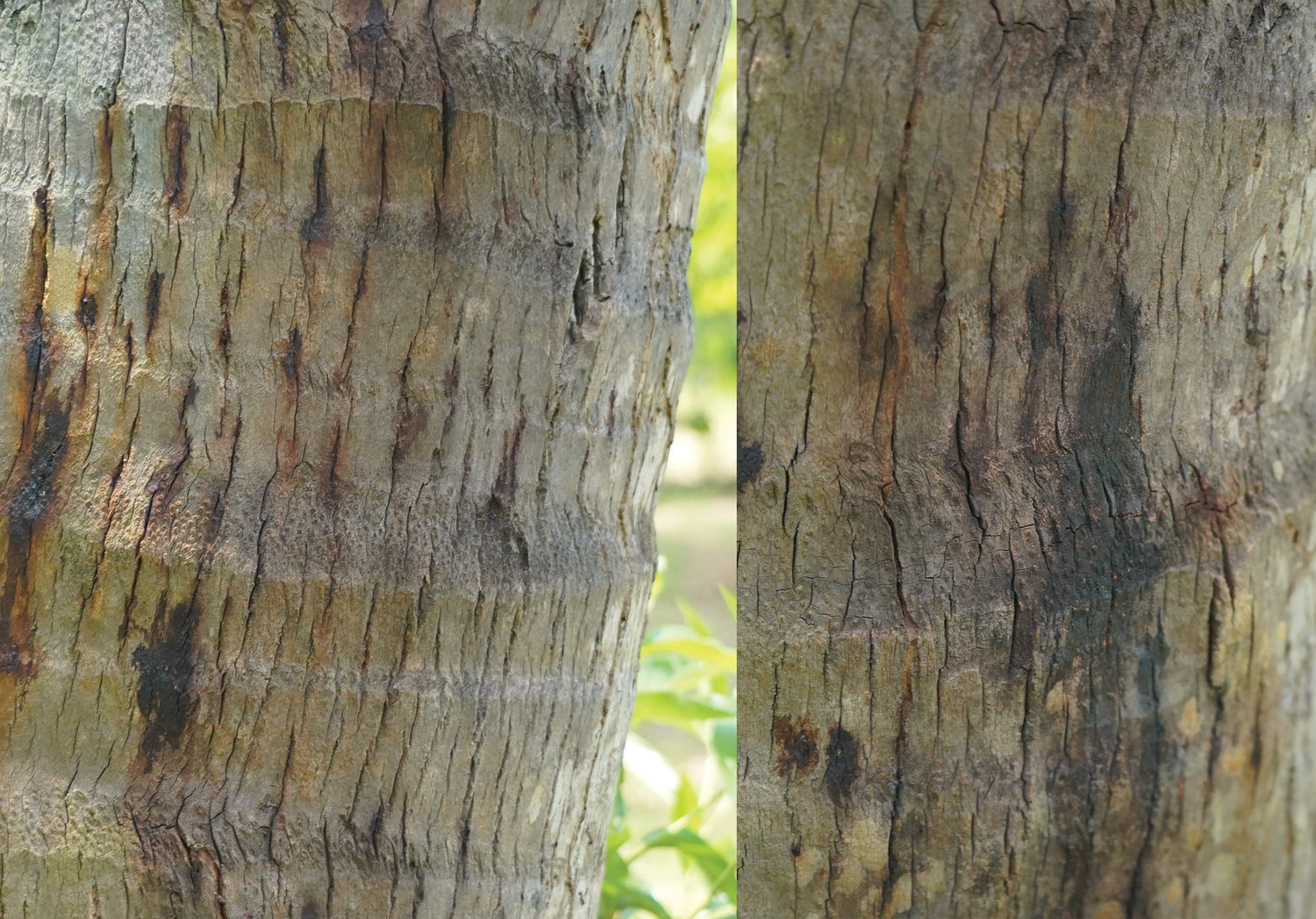TANJORE WILT/ BASAL STEM END ROT/ GANODERMA WILT: Ganoderma lucidem and Ganoderma applanatum
The disease was Originally discovered in Tamil Nadu in 1952, Ganoderma wilt has since spread to other coconut-growing regions, affecting coconut plantations, especially those with lighter soils along coastal districts. This fungal disease, caused by Ganoderma species like G. lucidum and G. applanatum, is characterized by two main symptoms: first, leaves become yellow and droop, and then reddish-brown liquid leaks out of cracks in the trunk. Affected tissues deteriorate with the disease, resulting in basal stem rot and palm death in the end. In order to minimize the disease's catastrophic effects on coconut cultivation, integrated approaches are essential for disease control, including the use of chemical treatments involving fungicides such as carbendazim and Bordeaux mixture.
Symptom
Coconut palms are severely affected by ganoderma wilt, also known as Thanjavur wilt or Anabe roga. It starts with the outer leaves turning yellow and drooping, and then there's a reddish-brown liquid that seeps through the cracks in the trunk, signifying serious internal rot. The disease causes the bark to become brittle and peel off in flakes as the internal tissues become discoloured and crumble, releasing an unpleasant stench. The emergence of distinctive bracket-like fungal structures at the base of the trunk during the rainy season serves as additional evidence of the palm's decline. If left untreated, the illness eventually results in palm death.
Management strategies for Ganoderma wilt include cultural, biological, and chemical approaches. Cultural methods involve the removal and destruction of infected palms to prevent further spread. Biological control agents such as Trichoderma and Bascillus spp. are applied to suppress fungal growth. Chemical treatments like Carbendazim are utilized to treat root zones and wounds, inhibiting Ganoderma proliferation. Integrated disease management combining these methods is crucial for effectively managing Ganoderma wilt and sustaining coconut production in affected areas.

Etiology
Two Ganoderma species— G. lucidum and G. applanatum are responsible for ganoderma disease in coconuts. Regardless of the severity of the bleeding symptom, these were isolated from the roots of infected palms. It has been determined that G. lucidum is pathogen by inoculating the fungus in the trunk area. Sandy or sandy loam soils in coastal regions where coconut is grown under rainfed conditions, as well as neglected plantations, are prone to ganoderma wilt disease. It was discovered that the disease spreads more easily in areas with old infections, in dry soil during the summer and rainy seasons, also when cultural practices are neglected. The illness cause leaves drooping There was an increase in sporocarp (fruiting body) formation at the base of the palm between March and August. The weevil Diocalandra stigmaticollis and the scolytid beetle Xyleborus perforans easily infest the Ganoderma affected trunk, hastening the palm's demise.
Management
Cultural method
Proactive measures to slow down the spread of Ganoderma wilt are part of the cultural management of the disease. First and foremost, in order to stop additional contamination, all infected coconut palms need to be quickly located and removed. Furthermore, growing crops of green manure which are then tilled back into the soil prior to flowering—improves soil quality and lowers the burden of disease. These customs not only remove unhealthy palms but also improve the condition of the soil, which makes it harder for Ganoderma to proliferate. Cultural techniques like the removal of affected palm trees and biological interventions using helpful microorganisms like Bascillus spp. and Trichoderma are the management strategies to be adopted
Biological method
The use of biological control techniques is essential for the sustainable management of Ganoderma wilt. Ganoderma fungus can be inhibited by directly applying beneficial microorganisms like Bascillus spp. and Trichoderma viride to the palms. Moreover, adding organic amendments like neem cake and farmyard manure (FYM) and supplementing with Phosphobacteria and Azotobacter strengthens palm resistance and increases soil fertility. These biological treatments improve the root environment and help the coconut palms fight off fungal infections more successfully. Application of 200 g of Bascillus spp. (Pf-1) and 200 g of Trichoderma viride per palm per year is recommended to suppress Ganoderma fungi. Enhancing soil health with the application of 200 grams each of Phosphobacteria and Azotobacter mixed with 50 kg of FYM per palm annually. These measures strengthen the palms' resistance to disease and improve overall soil fertility
Chemical method
An essential part of managing Ganoderma wilt is chemical intervention. To properly seal wounds, treat bleeding patches on the stem with 5% Tridemorph (calxin) and then hot coal tar. 2 ml of Aureofungin-sol and 1 gram of copper sulfate per palm, blended in 100 ml of water are to be applied through root feeding. Apply 100 ml of water to 2 ml of Tridemorph or 1ml of Hexaconazole three times every three months. Additional defence against Ganoderma wilt is provided by soaking the trunk in 1% Bordeaux mixture (40 l) within a 1.5-meter radius. Together with biological and cultural techniques, these exact chemical applications effectively controls Ganoderma wilt in coconut palms.
